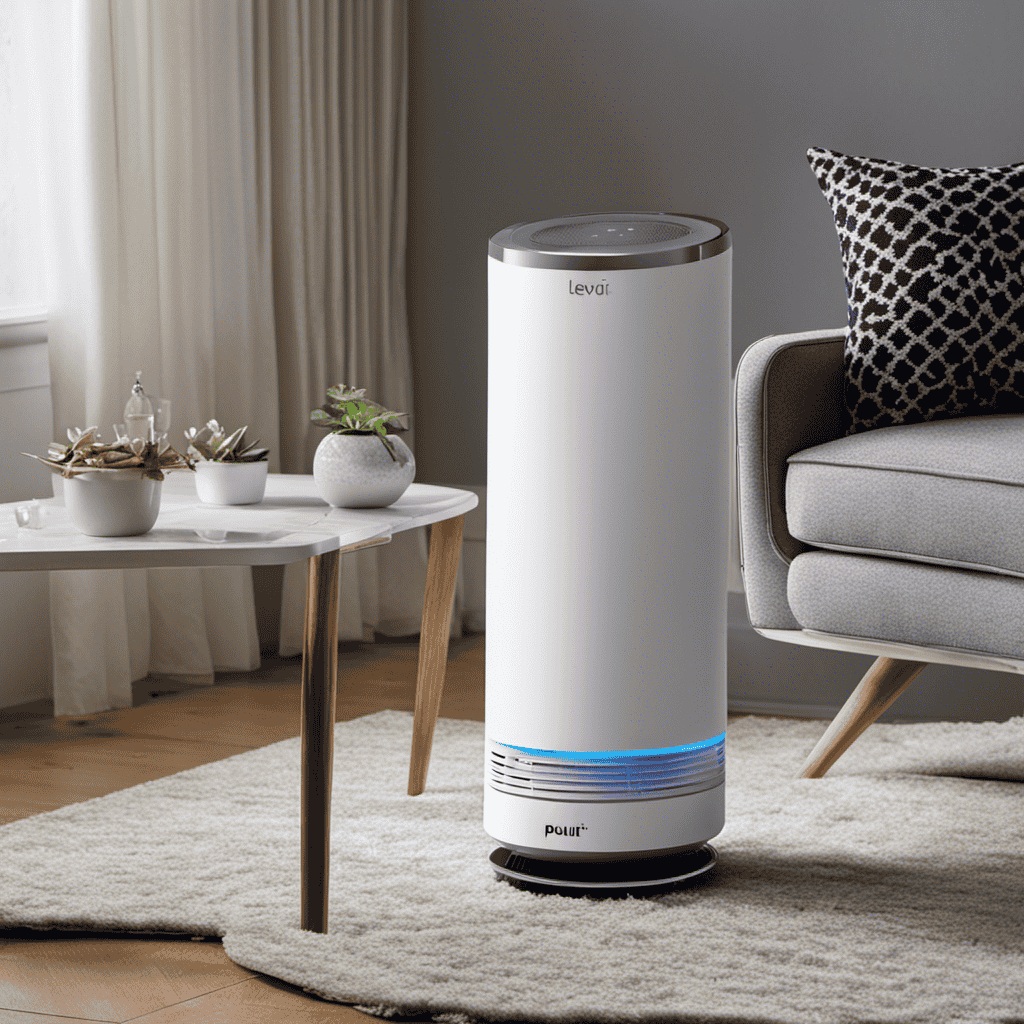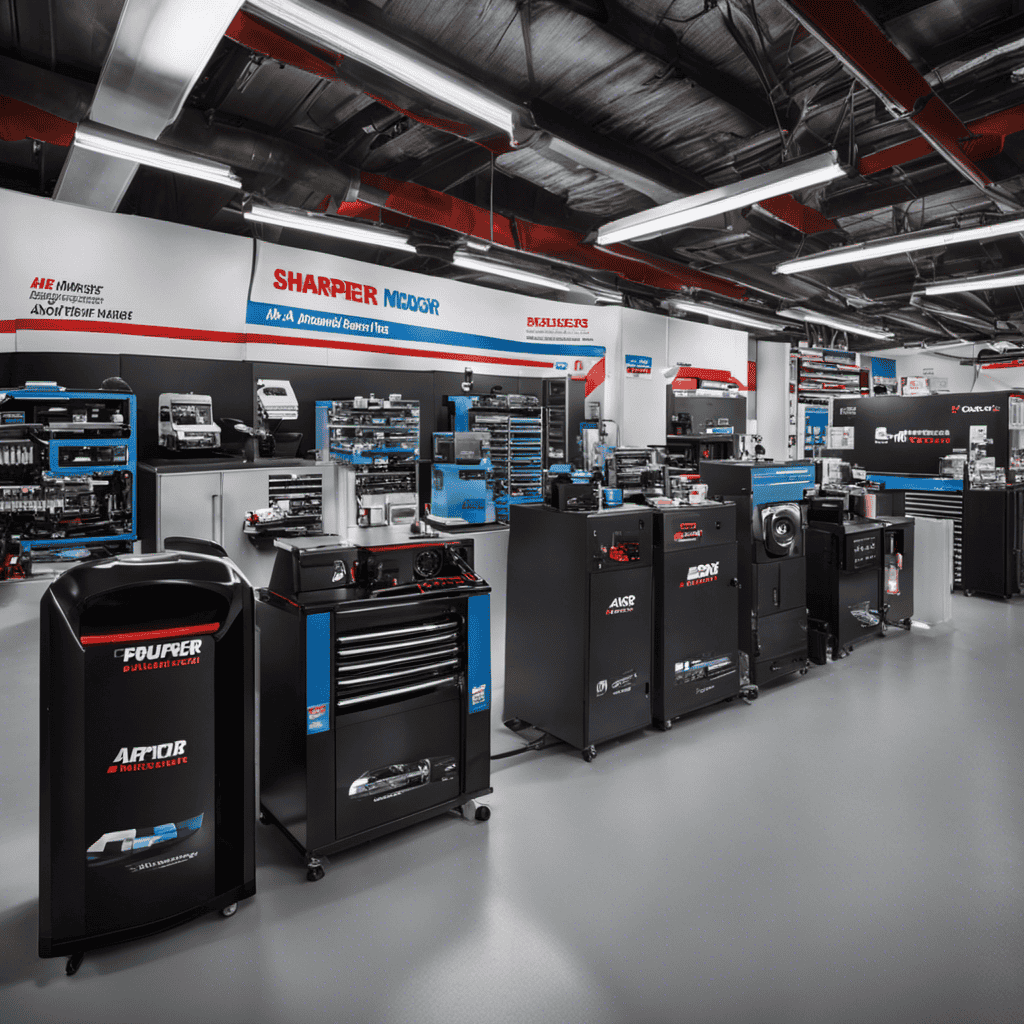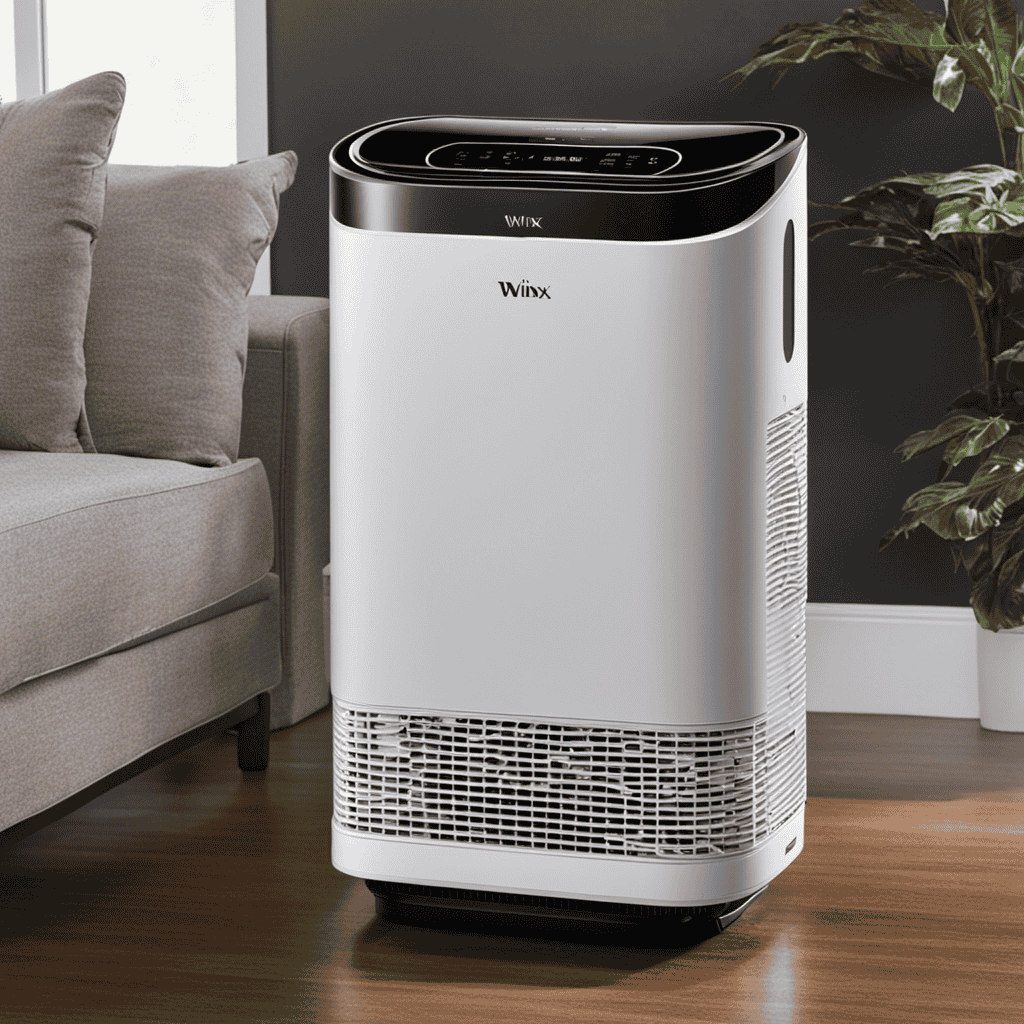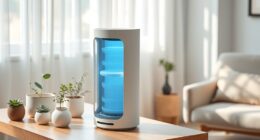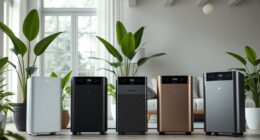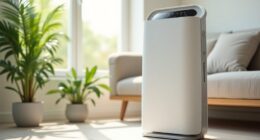I firmly believe in the importance of clean air, and I can attest that an air purifier can make a significant difference.
Picture this: the crisp, refreshing feeling of taking a deep breath without worrying about allergens, pet dander, or airborne viruses.
With an air purifier, you can experience improved indoor air quality, reduced symptoms of chemical sensitivities, and even long-term cost savings.
In this article, we will explore the numerous health benefits of air purifiers and why investing in one is a wise decision.
Key Takeaways
- Air purifiers improve indoor air quality by reducing air pollution.
- They remove contaminants such as dust, pet dander, pollen, and mold spores.
- Air purifiers alleviate symptoms of allergies and respiratory problems.
- Investing in an air purifier contributes to a healthier living environment.
Health Benefits of Air Purifiers
You’ll be amazed at how air purifiers can improve your health.
Air purifiers are highly effective in reducing air pollution, which can have significant health implications.
Studies have shown that indoor air is often more polluted than outdoor air, due to the presence of various pollutants such as dust, allergens, and volatile organic compounds (VOCs).
These pollutants can cause respiratory problems, allergies, and even contribute to the development of chronic diseases.
By using an air purifier, you can effectively reduce the levels of these harmful pollutants in your home or office, creating a healthier environment for you and your family.
Air purifiers work by filtering the air, trapping and removing contaminants, and improving overall air quality.
Investing in an air purifier is a smart choice for anyone concerned about their health and well-being.
Reducing Allergens in Your Home
To effectively reduce allergens in your home, consider investing in an air purifier that filters out dust, pollen, and pet dander.
Air purifiers have numerous health benefits, primarily related to improving indoor air quality. Allergens such as dust mites, pollen, and pet dander can trigger allergies and respiratory issues, leading to discomfort and reduced quality of life.
By removing these allergens from the air, air purifiers can help alleviate symptoms and create a healthier living environment. High-quality air purifiers use advanced filtration technologies to capture and trap particles as small as 0.3 microns, ensuring that the air you breathe is free from harmful pollutants.
Improving Indoor Air Quality
Improving indoor air quality is essential for maintaining a healthy living environment. When it comes to achieving cleaner air, air purifiers can be an effective tool. Here are some key points to consider:
-
Air purifiers effectively remove pollutants such as dust, pet dander, pollen, and mold spores from the air, improving overall indoor air quality.
-
Different air purification techniques, such as HEPA filtration and activated carbon filters, target specific types of pollutants, ensuring a thorough purification process.
-
Air purifiers with advanced features like UV-C light and ionization can further enhance their effectiveness by eliminating viruses, bacteria, and volatile organic compounds (VOCs).
-
Regular maintenance and filter replacement are crucial for maintaining the efficiency of air purifiers and ensuring optimal air purification.
Eliminating Pet Dander and Odors
Eliminating pet dander and odors is a common concern for many homeowners, especially those with pets. Pet allergies can be a major issue for individuals who are sensitive to pet dander. In order to create pet-friendly homes, it is important to address these concerns. One effective solution is using an air purifier specifically designed to tackle pet-related issues. These devices work by capturing and trapping pet dander particles and neutralizing pet odors, helping to improve indoor air quality. By using HEPA filters and activated carbon filters, air purifiers can effectively remove allergens and unpleasant smells from the air. This can be particularly beneficial for individuals with pet allergies, as it reduces the presence of allergens that can trigger symptoms. Overall, incorporating an air purifier into your home can contribute to a healthier and more comfortable living environment for both you and your pets.
| Pros | Cons |
|---|---|
| Removes pet dander and odors | Requires regular filter replacement |
| Improves indoor air quality | Can be noisy |
| Reduces pet allergy symptoms | Initial cost of purchasing an air purifier |
Removing Dust and Pollen From the Air
When it comes to discussing the benefits of air purifiers, two key points that often come up are allergy relief and improved indoor air quality.
Air purifiers are designed to remove allergens from the air, such as dust and pollen, which can trigger allergies and respiratory issues. By filtering out these particles, air purifiers can provide relief for those suffering from allergies and help improve overall indoor air quality.
Allergy Relief Benefits
If you suffer from allergies, an air purifier can provide you with much-needed relief. Allergies can be a constant source of discomfort and can greatly affect your respiratory health. Here are four reasons why an air purifier can be beneficial for allergy prevention and overall respiratory health:
-
Removes allergens: An air purifier can effectively filter out common allergens such as dust mites, pet dander, pollen, and mold spores, reducing your exposure to these triggers.
-
Improves indoor air quality: By removing airborne particles and pollutants, an air purifier helps to create a cleaner and healthier environment for you to breathe in.
-
Reduces symptoms: With cleaner air, you may experience a decrease in allergy symptoms such as sneezing, coughing, itching, and congestion.
-
Enhances sleep quality: By reducing allergens in the air, an air purifier can help improve sleep quality by minimizing nighttime allergy symptoms that may disrupt your sleep.
Investing in an air purifier can go a long way in providing relief from allergies and improving your respiratory health.
Improved Indoor Air Quality
After discussing the allergy relief benefits of air purifiers, let’s delve into the topic of improved indoor air quality.
Indoor air pollution is a serious concern, as it can lead to various health issues such as respiratory problems, allergies, and asthma. The air we breathe indoors can contain pollutants like dust, pet dander, mold spores, and volatile organic compounds (VOCs) from cleaning products and furniture.
To ensure a healthy living environment, it is essential to meet air quality standards. Air purifiers play a vital role in achieving this goal by efficiently removing these harmful pollutants from the air. They use filtration systems to capture and trap particles, thereby improving the overall quality of indoor air.
Managing Asthma and Allergies
To manage your asthma and allergies, you should consider getting an air purifier. An air purifier can help you in various ways to reduce the triggers that can worsen your condition. Here are four reasons why an air purifier is beneficial for managing asthma and allergies:
-
Removes allergens: An air purifier can effectively remove common allergens such as pollen, pet dander, and dust mites from the indoor environment.
-
Filters out pollutants: Indoor pollution can aggravate asthma symptoms. An air purifier can eliminate harmful pollutants like smoke, volatile organic compounds (VOCs), and mold spores.
-
Improves air circulation: Proper air circulation is crucial for maintaining good indoor air quality. An air purifier can help to circulate clean air throughout the room, reducing the concentration of asthma triggers.
-
Creates a clean environment: With an air purifier, you can have a cleaner and healthier indoor environment, free from airborne particles that can irritate your respiratory system.
Minimizing the Risk of Respiratory Infections
As we continue our discussion on indoor air quality, it is essential to address the topic of minimizing the risk of respiratory infections.
One key aspect of this is airborne pathogen protection, which involves implementing measures to reduce the transmission of infectious agents through the air.
Additionally, enhancing indoor air quality plays a crucial role in creating a healthier environment by removing pollutants and improving ventilation, ultimately reducing the chances of respiratory infections.
Airborne Pathogen Protection
If you want to protect yourself from airborne pathogens, you should consider getting an air purifier. Air purifiers are highly effective in filtering out harmful particles and microorganisms from the air, ensuring cleaner and healthier indoor environments. Here are four reasons why air purifiers are a worthy investment:
-
Effective filtration: Air purifiers use advanced filtration systems that can capture and remove airborne pathogens such as bacteria, viruses, and mold spores, reducing the risk of respiratory infections.
-
HEPA technology: High-Efficiency Particulate Air (HEPA) filters are commonly used in air purifiers due to their ability to trap particles as small as 0.3 microns with 99.97% efficiency, ensuring optimal air quality.
-
UV-C light: Some air purifiers incorporate UV-C light technology, which helps in killing or inactivating airborne pathogens, further enhancing the purification process.
-
Activated carbon filters: Air purifiers equipped with activated carbon filters can effectively eliminate odors, chemicals, and volatile organic compounds (VOCs) from the air, promoting a fresh and clean living space.
Investing in an air purifier with advanced air purification technology can significantly improve indoor air quality and provide protection against airborne pathogens.
Enhancing Indoor Air Quality
Investing in an air purifier equipped with advanced filtration technology can greatly improve the quality of indoor air. Not only does it provide numerous benefits for your health and well-being, but it also enhances the overall comfort of your living space. By effectively removing pollutants and allergens from the air, air purifiers help reduce the risk of respiratory issues and allergies. They also eliminate unpleasant odors, making your home a more pleasant environment. Additionally, air purifiers can help create a cleaner and safer space, especially for those with compromised immune systems. The table below highlights some of the key benefits of using an air purifier:
| Air Purifier Benefits | Air Quality Improvement |
|---|---|
| Removes pollutants | Reduces allergens |
| Eliminates odors | Promotes respiratory health |
| Creates a cleaner and safer environment | Enhances overall comfort |
Investing in an air purifier is a wise choice for improving indoor air quality and ensuring a healthier living space. Now, let’s delve into the next section and explore the process of filtering out harmful airborne particles.
Filtering Out Harmful Airborne Particles
Filtering out harmful airborne particles is one of the main reasons to get an air purifier. Air purifiers are designed to improve air quality by trapping and removing pollutants from the air we breathe. Here are four key benefits of using an air purifier:
-
Reducing allergens: Air purifiers can capture common allergens like pollen, pet dander, and dust mites, helping to alleviate symptoms and improve indoor air quality.
-
Removing airborne bacteria and viruses: Air purifiers with HEPA filters can effectively capture and eliminate airborne pathogens, reducing the risk of respiratory infections.
-
Eliminating odors: Air purifiers equipped with activated carbon filters can remove unpleasant odors caused by smoke, cooking, pets, and other sources.
-
Filtering out harmful gases and chemicals: Certain air purifiers are designed to remove volatile organic compounds (VOCs) and other harmful chemicals, creating a safer environment.
By improving air quality and reducing respiratory issues, air purifiers play a crucial role in promoting healthier living.
Transitioning to the next section, cleaner air can also enhance sleep quality.
Enhancing Sleep Quality With Cleaner Air
When it comes to the topic of air purifiers and insomnia, there is a growing body of scientific research that suggests a potential link between cleaner air and improved sleep quality.
Studies have shown that air purifiers can effectively filter out common allergens and pollutants, such as dust mites, pollen, and pet dander, which are known to trigger allergies and respiratory issues that can disrupt sleep.
Air Purifiers and Insomnia
If you’re having trouble sleeping, an air purifier might help alleviate your insomnia. Air purifiers have been shown to have a positive impact on both allergies and respiratory health, which can directly affect sleep quality.
Here are four reasons why air purifiers can help improve your sleep:
-
Reduction of allergens: Air purifiers capture and eliminate common allergens such as dust mites, pet dander, and pollen, reducing the risk of allergic reactions that can disrupt sleep.
-
Removal of airborne pollutants: Air purifiers can effectively remove harmful pollutants like smoke, mold spores, and volatile organic compounds (VOCs), ensuring cleaner air for better respiratory health.
-
Humidity control: Some air purifiers come with built-in humidifiers, which can help regulate the moisture levels in your bedroom, preventing dryness that may cause discomfort during sleep.
-
White noise production: Many air purifiers operate with a gentle hum, producing white noise that can be soothing and mask other disruptive sounds, promoting a more peaceful sleep environment.
Benefits of Cleaner Air
Having cleaner air in my home can lead to improved respiratory health and a better night’s sleep. Indoor air quality plays a significant role in our overall well-being, and maintaining good air quality has numerous health benefits.
Poor indoor air quality can contribute to respiratory issues such as asthma and allergies, making it essential to prioritize clean air in our homes. Air purifiers are effective in removing airborne pollutants such as dust, pollen, pet dander, and mold spores, improving the overall air quality. This can reduce the risk of respiratory illnesses and help alleviate symptoms for those already affected.
Additionally, cleaner air promotes better sleep by reducing irritants that may cause discomfort and disrupt sleep patterns. By investing in an air purifier, one can enjoy the health benefits of cleaner indoor air and experience a more restful sleep.
Creating a Fresh and Pleasant Living Environment
To create a fresh and pleasant living environment, you should consider getting an air purifier. Air purifiers have been proven to effectively remove pollutants and allergens from the air, resulting in cleaner and fresher air to breathe.
Here are four reasons why an air purifier is essential for improving your well-being:
- Eliminates airborne allergens such as pollen and pet dander, reducing the risk of allergies and respiratory issues.
- Removes harmful particles like dust, smoke, and volatile organic compounds (VOCs), promoting a healthier indoor environment.
- Reduces unpleasant odors caused by cooking, pets, or mold, creating a more pleasant atmosphere.
- Improves sleep quality by filtering out airborne irritants, allowing you to wake up feeling refreshed and rejuvenated.
By investing in an air purifier, you can enjoy the benefits of fresh air and improved well-being, which will ultimately contribute to your overall quality of life.
Now, let’s explore how air purifiers can increase productivity and focus.
Increasing Productivity and Focus
When it comes to improving productivity and focus, one often overlooked factor is the quality of the air we breathe. Research has shown that cleaner air can have a significant impact on our cognitive abilities, allowing us to think more clearly and stay focused for longer periods of time.
Cleaner Air, Better Focus
Breathing in cleaner air can help me focus better throughout the day. When the air quality is poor, it can lead to various health issues and hinder my ability to concentrate. However, by improving the air quality, I can experience several benefits that enhance my focus and productivity.
Consider the following:
-
Reduced allergens and irritants: Cleaner air means fewer allergens like pollen and dust mites, reducing the chances of allergies and respiratory problems that can distract me.
-
Elimination of odors: Unpleasant odors in the environment can be distracting and affect my ability to concentrate. Cleaner air helps to eliminate these odors, creating a more pleasant and focused atmosphere.
-
Removal of airborne particles: Dust, pet dander, and other airborne particles can accumulate in the air, impacting the quality of the environment. By purifying the air, these particles are removed, promoting better concentration.
-
Enhanced oxygen levels: Clean air typically contains higher levels of oxygen, which is vital for brain function. By breathing in cleaner air, my brain receives the optimal amount of oxygen, improving focus and cognitive abilities.
With these air quality benefits, it’s clear that investing in an air purifier can significantly improve concentration and overall productivity throughout the day.
Boost Productivity With Purifier
Investing in an air purifier can significantly enhance productivity by improving air quality and eliminating distractions. Airborne pollutants, such as dust, allergens, and volatile organic compounds (VOCs), can negatively impact concentration and cognitive function. Research has shown that poor air quality can impair cognitive performance and increase fatigue, leading to decreased productivity.
By removing these pollutants, air purifiers create a healthier indoor environment, allowing individuals to focus better and think more clearly. Furthermore, air purifiers can help boost concentration by reducing odors, such as cooking smells or chemical fumes, which can be distracting and disrupt cognitive function.
With improved air quality, the brain receives more oxygen, leading to enhanced cognitive function and increased productivity. Investing in an air purifier is a proactive step towards creating an optimal work environment that promotes concentration and productivity.
Reducing the Spread of Airborne Viruses
Using an air purifier can help lower the risk of spreading airborne viruses. Air purifiers are an effective tool in preventing respiratory illnesses and reducing the spread of germs. Here are four reasons why you should consider getting an air purifier:
- Air purifiers filter out harmful particles, such as bacteria and viruses, from the air, reducing the chance of inhaling them.
- They help remove allergens like pollen and dust mites, which can trigger respiratory symptoms and worsen existing conditions.
- Some air purifiers use UV-C light technology to kill germs and bacteria, providing an additional layer of protection.
- Air purifiers with HEPA filters can capture ultrafine particles, including those carrying viruses, preventing them from circulating in the air.
Alleviating Symptoms of Chemical Sensitivities
If you’re sensitive to chemicals, an air purifier can provide relief by removing harmful substances from the air you breathe. Chemical sensitivity is a condition where individuals experience adverse reactions when exposed to certain chemicals. These reactions can range from mild symptoms such as headaches and nausea to more severe respiratory issues.
Studies have shown that air purifiers are effective in reducing the levels of chemicals in indoor air, thereby alleviating symptoms for those with chemical sensitivities. These devices use filters or other technologies to capture and trap airborne pollutants, including volatile organic compounds (VOCs) and other harmful chemicals. By removing these substances, air purifiers create a cleaner and healthier indoor environment, promoting overall well-being.
However, it’s important to note that air purifiers may not completely eliminate all chemicals, especially if the source is persistent or continuously reintroduced. Therefore, it is crucial to address the source of the chemicals as well.
Now let’s discuss how air purifiers can also help in eliminating mold and mildew spores.
Eliminating Mold and Mildew Spores
Eliminating moisture buildup is crucial in preventing the growth of mold and mildew spores, which can have detrimental effects on our health. These spores can trigger allergies, asthma attacks, and other respiratory issues. An air purifier can be an effective solution to combat these problems by filtering out mold and mildew spores from the air.
Here’s why getting an air purifier is beneficial in eliminating mold and mildew spores:
- Removes airborne mold particles, reducing the risk of exposure.
- Filters out moisture droplets that can contribute to mold growth.
- Improves indoor air quality, creating a healthier living environment.
- Reduces the likelihood of respiratory issues caused by mold and mildew spores.
Long-Term Cost Savings With an Air Purifier
Investing in an air purifier can save you money in the long run. Not only does it improve the quality of air you breathe, but it also offers cost savings through energy efficiency and reduced noise levels.
Energy efficiency is an important consideration when choosing an air purifier. Look for models that are ENERGY STAR certified, as they consume less energy without compromising performance. These energy-efficient units can help lower your electricity bills over time.
Additionally, noise levels play a significant role in the overall satisfaction of an air purifier. Opt for models with low noise levels, especially if you plan to use it in your bedroom or office space. A quiet air purifier ensures undisturbed sleep and a peaceful working environment.
Frequently Asked Questions
Can an Air Purifier Completely Eliminate All Allergens From My Home?
No, an air purifier cannot completely eliminate all allergens from my home. While it can reduce pet dander and pollen, it may not remove them entirely. It’s important to consider other methods for reducing allergens as well.
How Often Should I Replace the Filters in My Air Purifier?
I replace the filters in my air purifier every three months to ensure optimal performance. Regular maintenance is crucial as it helps to remove pollutants effectively and maintain clean indoor air quality.
Can an Air Purifier Remove Cigarette Smoke and Its Odor?
Yes, an air purifier can effectively remove cigarette smoke and its odor. Regular maintenance, such as replacing filters, is important for optimal performance. I recommend investing in an air purifier for a cleaner and healthier indoor environment.
Are There Any Potential Risks or Side Effects Associated With Using an Air Purifier?
There may be potential health risks and common side effects associated with using an air purifier. It is important to research and understand these risks before deciding to get one.
Will an Air Purifier Help Reduce the Spread of COVID-19 or Other Viruses?
An air purifier can be effective in reducing respiratory infections, including the spread of viruses like COVID-19. Different air purifier technologies are compared for their virus removal capabilities.
Conclusion
In conclusion, I can’t help but marvel at the remarkable benefits of air purifiers. It’s almost like they have a secret power to improve our health and well-being.
From reducing allergens and pet dander to eliminating dust and pollen, these devices work tirelessly to create a clean and refreshing indoor environment.
Plus, they even help in reducing the spread of airborne viruses and alleviating symptoms of chemical sensitivities.
With the added bonus of long-term cost savings, investing in an air purifier seems like a no-brainer. Trust me, your lungs will thank you.

